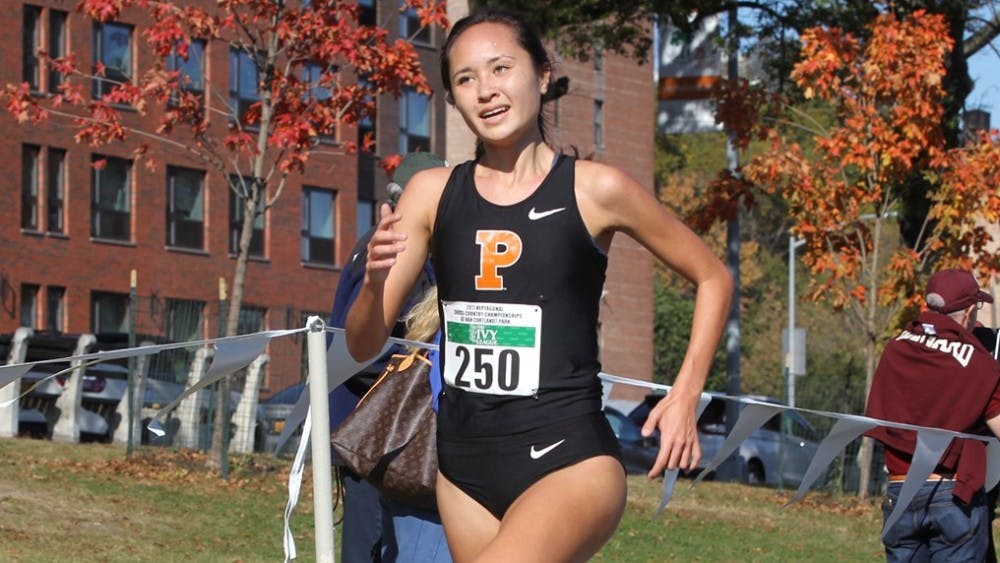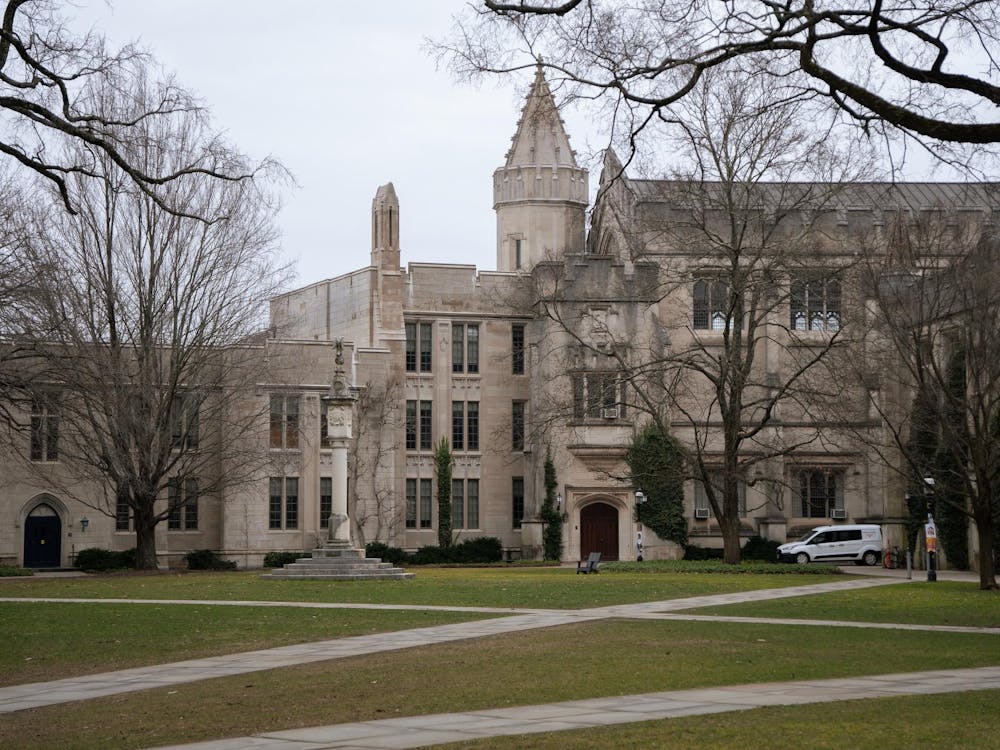Starting his third season, head women’s cross country coach Brad Hunt hopes to lead his team to an Ivy League title. Things look promising for the Tigers: after taking first at the Harvard-Yale-Princeton annual matchup, women’s cross country is off to a speedy start. Hunt has recruited two powerhouse underclassmen classes, and the team possesses depth, experience, as well as strong leadership from its nine seniors.
But here’s what’s also looking good for the future of the Tigers’ season: women’s cross country is starting this season healthy. This feat is far from luck. It’s easy to try to evaluate Hunt’s coaching success in terms of certain numbers: team finishes, mile splits, time-spreads across top runners, personal records. But Hunt has a huge statistical victory that isn’t plastered over GoPrincetonTigers.com: he’s significantly decreased team injuries.
“It’s something we’ve been working on tremendously,” said Hunt. “Coming in, 33 percent of the team had a bone related injury. At the end of year two, we worked hard to bring that number to around 10 percent,” he said.
Injuries in women’s cross country are shockingly common; however, injury data in cross country is hard to quantify, because injuries in cross country are predominantly from overuse. Often, they are not dramatic ACL tears or broken arms. Instead, something that aches a little can start to really ache — and lend itself to a soft tissue injury. A stress reaction can become a stress fracture. To normalize data, the NCAA statistically defines an “injury” in terms of “time loss.” The NCAA collects data on injuries through a formula that considers the total time, amount of practices, and games that an athlete was physically unable to attend, multiplied by the amount of “exposures” to the sport. Based off of this sort of “injury data,” NCAA women’s cross country still has a higher rate of injury than other individual sports — women’s tennis, women’s swimming and women’s indoor track, to name a few. What’s more: this data does not account for less severe injuries; Princeton only considers severe soft tissue injuries and bone injuries in its data. Thus, if injuries were defined differently, the data would show even higher rates of cross-country injuries. Another consideration is that cross country athletes compete in three seasons: cross country, indoor track, and outdoor track. Injury prevention is key; not only do injuries in women’s cross-country threaten team performance, but they can have long-lasting implications on the health of individual.
How has Hunt reduced injury so drastically? The seemingly simple question introduces a complex answer. In Hunt’s overhaul of the cross-country program, he’s taken deliberate measures to keep his athletes healthy.
Creating training plans for his athletes, Hunt takes a preventative approach. First, athletes are on intensely individualized training plans. There is no one-size-fits-all; healthy athletes are running anywhere from 20—65 miles in a week.
“He is very conservative when it comes to training plans and athletic development,” said trainer Jodi Schneider. Schneider is technically an employee of UHS, but in her own words, she is a “service provided to athletics.” She is “in no way influenced by the athletic department,” she said. Many other trainers across the country are directly hired by the athletics program, which can impact the authenticity of the communication between coaches and trainers. At other institutions, trainers may worry about trying to please the coaches, and would consider an athlete’s holistic health profile. But at Princeton, this is not the case. Nonetheless, the relationship between Hunt and Schneider is unique.
“I think our trainer is phenomenal,” said Hunt, about Schneider. “We see so much eye to eye on what it means to be a healthy woman distance runner.” Similarly, Schneider echoed Hunt’s remarks. “Coach Hunt and I work very well together,” said Schneider. “It’s really helpful that we are both saying the same thing. He is unique amongst coaches. He’s always thinking long term,” she said.
The cross country team also works in close conjunction with other professionals. Along with Schneider, the team works with sports nutritionist Alexa McDonald as well as sports psychologists and massage therapists. Additionally, last year, Jeremy Johnson was hired to take charge of strength training for the team.
Hunt demands a lot from his athletes, and challenges them with tough workouts and high expectations. But perhaps, Hunt’s most difficult expectation is that his athletes rest.
“Not training today is part of the plan. Rest is a verb. It’s the active concept of doing nothing. It is a key to sustainable success,” said Hunt.
Hunt gives his athletes an “off day” on Mondays. The choice of Monday is intentional — athletes can start their week feeling well-rested and on top of their school work. “It’s about finding the balance of the institution,” said Hunt. He also gives his team a whole weekend “off” during the middle of the season in the midst of competition season. This falls close to midterms, which Hunt recognizes as the “most demanding time on campus.” It is noteworthy that women’s cross country maintains an outstanding team GPA (3.5); Delaney Miller graduated last year with the highest GPA among Princeton senior athletes. Getting athletes to rest “can be really difficult for them,“ Schneider explained. “Trying to get them to understand that more is not always more.”

Alongside Hunt’s conservative training plans, he places the onus on the athlete to take care of themselves.
“So many things within our control are directly related to variables that correlate to injury,” he explained. Hunt pushes his athletes to be honest with themselves about how they are feeling. First, apart from scheduling in time to “rest,” Hunt expects athletes to ask for an off day when they need it.
Hunt recruits athletes based on their habits: he said he asks recruits how many hours of sleep they get every night during the recruiting process and looks for “great healthy habits in their approach to academics, athletics, and life.” Hunt referenced how athletes don’t suddenly change their sleeping patterns when they get to college.
Perhaps most interesting of all is how Hunt has created a truly unique team culture to combat injury. Schneider and Hunt both referenced the “distance runner mentality” that is often present in top cross country athletes. With the “distance runner mentality…. You learn very early to not listen to what your brain is saying. You’re rewarded by not listening to what your body is telling you,” said Schneider.
“Distance runners get comfortable being uncomfortable,” added Hunt. But, after working with women’s cross country for six years, Schneider has noticed a discernible shift in the culture of the team. “The biggest change is that the culture on the team is far healthier than it used to be,” said Schneider. “If someone is trying to run through pain, they’ll be called out for it. I give the team a lot of credit for that,” he said. Schneider also noted how the team is unafraid to talk about “taboo topics” such as menstruation concerns and body image. “The supportiveness of the team environment is what protects them.”
Despite all injury-prevention measures: injuries still happen. “There’s always distance runners in the training room, and there always will be,” said Schneider. For these injured athletes, Hunt does not overlook the importance of the recovery process. Hunt referenced Elizabeth Bird ’17 and Katie Hanss ’17 as examples of athletes who experienced serious injuries during their time at Princeton, but rebounded to come back faster. Hunt encourages athletes to “embrace the rehabilitation” so that they can come out “stronger, healthier, and more durable … ideally having learned how they might tweak and adjust their approach.”
Take freshman Page Lester: a two-time Footlocker National Finalist, coming in 14th as a senior, and a triathlete competitor, Lester is one of the nation’s top recruits. After Lester had committed to Princeton in 2017, she fractured her sacrum, and has been on the road to recovery since. She had anticipated a two to three month break from running, but had not anticipated a six to seven month layoff.
“Page is a great example of a tremendous elite level success … somebody who is motivated and driven. She’s an endurance athlete who is willing to persevere. She’s been so receptive to taking a step back, and learning about herself,” said Hunt.
Lester’s story of recovery mental growth is inspiring. Imagining a year without competing in running, Lester considered taking a gap year.
“Without running, I just had this hole in my life. I don’t want to say I’m dependent on running, but it was such a release for me,” said Lester. Lester even considered giving up running altogether, thinking “I never want to run again… this shouldn’t happen to anyone.” She met with Coach Hunt in July to discuss her options. “After I came up and visited, we talked through everything and ultimately, I decided to come to school. I’m really glad I did,” said Lester.
Lester has used the opportunity for intense personal growth. She has also re-evaluated her training. “It forced me to look back on other aspects of my life: nutrition, sleep and more.”
“Was all the training I was doing beneficial, or was I just training just to train? It’s not just the amount you run — there are a lot of other factors that could lead to a stress fracture.” Lester is beginning to run again, and you can spot her cross-training on the bike, elliptical, and pool.
“I’m not really doing workouts yet, but I’ll get there,” she said. “It’s hard because I’d love to be racing, but at the same time, I feel confident for the first time I actually have a plan. My training is more geared towards running and seeing everyone on the team makes me want to be healthy more than anything … and I know I can be at some point, I just have to be patient. Coach Hunt is amazing with all of it. He was really open to me doing what was best for me.”
But perhaps most inspiring of all is Lester’s team-first mentality surrounding her injury: Lester is fully invested in the team’s success.
“To anyone with injury — take a deep breath. It sucks, I know, it really sucks,” she said. “I really want my teammates to do well, and I’m really glad I feel that way. That’s what’s so great about the team. It’s so cohesive, everyone wants everyone to do well but at the same time if someone is hurt or not feeling good — there are people that want to support you.”









